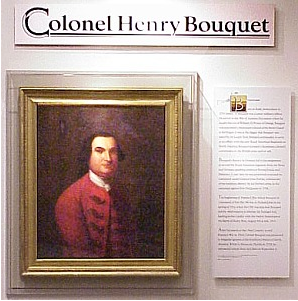Bushy Run Battlefield

Westmoreland County, Pennsylvania
Bushy Run Battlefield preserves and interprets for citizens and visitors the site of this pivotal battle fought between British and Native Americans during the conflict known as Pontiac’s War (1763-64) and the role of this British victory in maintaining control of North America.
Goals
To present tours, exhibits and educational programs, that broaden public understanding and appreciation of Bushy Run Battlefield, Pontiac’s War, and the French and Indian War period. Major themes to be presented include:
- The strategy, tactics, action and participants in the battle, including the leadership and soldiers from the British, Colonial, and Native American forces.
- The significance of the battle to Fort Pitt, Pontiac’s War and the French and Indian War period in western Pennsylvania, interpreted collaboratively with Fort Pitt Museum and other period sites in the region.
- Pontiac’s War (1763-64), its causes, and its ties with the French and Indian War.
- Preservation and commemoration of the battle at this site.
To work with the Bushy Run Battlefield Heritage Society and other groups whose valued guidance and support enhance the mission and goals of the Pennsylvania Historical and Museum Commission.
History
The 213 acres of forested and grassy areas that comprise Bushy Run Battlefield, Westmoreland County, Pennsylvania, can be viewed as one large historical entity. The events that transpired here in August 1763, during Pontiac’s War, forever set Bushy Run apart as a place of historical significance. The battle near Bushy Run and the events of Pontiac’s War leading to the battle add to the understanding of the Indian-European culture clash, which is an important theme in American history. The battle also has a place in the broader study of American settlement and expansion, and possesses great significance in the realm of British, American and Indian military history.
A Significant Story
The British victory at Bushy Run was the critical turning point in Pontiac’s War. It also prevented the capture of Fort Pitt (Pittsburgh) and restored lines of communication between the frontier and eastern settlements. The British victory helped to keep the “gateway to western expansion” open.
Pontiac, an Ottawa chief in the Detroit areas, retaliated against British policies and control following the collapse of New France at the close of the French and Indian War. Because of Pontiac’s successful advances against the British, Indian revolts quickly spread eastward. His plans were covert until 1763 when attacks on British outposts began. By the end of July, nine British forts were captured, a tenth fort abandoned, and the great strongholds of Pitt and Detroit under siege. The geographic area affected included the present states of Pennsylvania, New York, Ohio, Indiana, Michigan, Wisconsin and parts of Maryland and West Virginia. Truly this was the greatest Indian threat to the British colonies during the 18th century.
Because the Indians so thoroughly controlled the frontier, information about the war filtered slowly east to the British high command. Once the scope of the situation was realized in late June, an expedition was organized to march west to Fort Pitt and then to proceed north and west to re-establish fallen forts. Colonel Henry Bouquet, a Swiss born professional soldier, commanded the expedition as it left Carlisle, Pennsylvania on July 18th. Indian scouts observed Bouquet’s army marching west along Forbes Road and reported this to the large force of Indians surrounding Fort Pitt. The Indians decided to temporarily end their siege and attack the British expedition in the open. The attack took place one mile east of Bushy Run Station on August 5th and 6th, 1763. The engagement resulted in a victory for the British.
A Unique History
Bushy Run Battlefield is the only historic site or museum that deals exclusively with Pontiac’s War, one of the most significant Native American conflicts in American History. The battlefield today is topographically intact. Combatants’ positions and maneuvers can be “seen” and understood and the wooded acres (90 acres) give a sense of the original environment at the time of the battle. Self-guiding trails, guided tours and interpretive programs return visitors to the days of the battle. Interpretive exhibits located in a modern Visitor’s Center aid the visitor in understanding the significance of the events that occurred at Bushy Run. Only historic sites, particularly battlefields, can give visitors this unique feeling. A sixth sense tells you something unique and important happened here, something that changed the lives of people and the progression of history.


